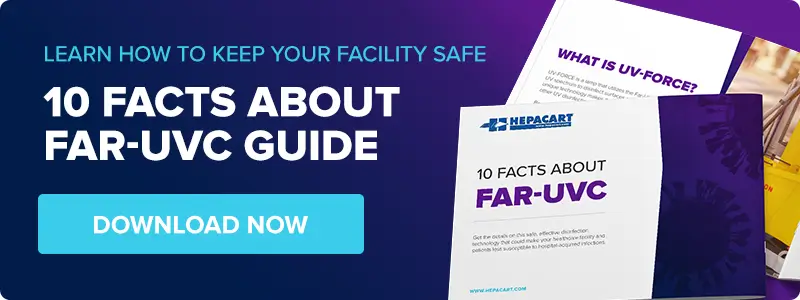Share this
Effective Infection Control: 4 Benefits of UV Light Disinfection
by HEPACART on Oct 24, 2019
Since being discovered as a disinfectant, UV light has been used in a broad range of applications.
The evolutionary development of UV light sterilization can trace its roots to a fascinating historical artifact you can view online, the 1878 paper On the Influence of Light upon Protoplasm by Arthur Downes and Thomas P. Blunt.
Since being discovered as a disinfectant, UV light has been used in a broad range of commercial, industrial, and medical applications, from water treatment to curing of inks and coatings to hygiene and infection control.
In the field of healthcare, today’s far-UVC disinfection lights — while evolved from older UV disinfection lights using UVC wavelengths — may be considered revolutionary, replacing not only conventional UV-C, but some conventional chemical cleaning and disinfection methods as well.
Let's take a look at four basic reasons why far-UVC disinfection is so different from UV-C that we believe it should be called revolutionary rather than merely evolutionary.
1. Far-UVC disinfection is faster and far more effective than UV-C
In a nutshell, UVC (wavelength around 222 nanometers) is superior to UV-C (around 254 nm) for disinfection in the following ways:
- More efficient at low dose rates.
- Much faster than UV-C - kills pathogens in seconds vs. minutes
- Higher absorption rate in bacteria and viruses.
- Safer for use around humans because it cannot penetrate skin or eyes.
- Physically destroys cells due to its shorter wavelength and higher photon energy than UV-C, which chemically changes bonds and causes mutations that prevent cells from replicating, but does not destroy them.
It seems strange that a small change in wavelength can make the enormous functional difference between far-UVC and UVC, but dozens of tests by independent labs have demonstrated far-UVC's lethality to a wide range of pathogens, including MRSA, VRE, and C. diff spores.
The speed and efficiency of far-UVC, as well as its safety for use around humans, make it ideal for hospital disinfection tasks, and have led to a variety of devices that employ far-UVC technology.
Tests of far-UVC on surfaces have demonstrated that it kills C. difficile spores in seconds versus 45 minutes for UV-C and hours for chemical cleaning. One such case is discussed in the paper Evaluation of a hand-held far-ultraviolet radiation device for decontamination of Clostridium difficile and other healthcare-associated pathogens.
2. Far-UVC is not dangerous to humans — it can't penetrate eyes and skin
A key advantage of far-UVC over the UV-C light used in most UV sterilization is that it cannot penetrate human skin or eyes. Far-UVC's shorter wavelength renders it unable to pass through the barrier of non-living cells on skin, and tears on the surface of the eye. At the same time, that wavelength is what makes it superior in penetrating and inactivating bacteria and viruses. (See the 2018 study Far UV-C light: A new tool to control the spread of airborne-mediated microbial diseases.
In fact, since far-UVC light is 10 to 1000 times safer to use around humans than traditional UV-C, it can be used to disinfect a room even when people are present. This makes it practical for daily disinfection tasks. According to the study cited above:
"Based on biophysical considerations and in contrast to the known human health safety issues associated with conventional germicidal 254-nm broad-spectrum UVC light, far UVC light does not appear to be cytotoxic to exposed human cells and tissues in vitro or in vivo."
3. Far-UVC is superior to conventional disinfection methods
There’s significant use of far-UVC air disinfection in healthcare settings and cleanroom environments. When far-UVC is combined with indoor air filtration, it virtually eliminates airborne microbes, even antibacterial-resistant ones. This makes it a crucial tool for meeting ICRA Class IV standards for protecting the highest-risk patients. Further, cleaning the air of pathogens can help minimize the chance of spreading a virus even as it mutates into something that may bypass the latest vaccines.
The inclusion of far-UVC light as a cleaning tool can reduce a hospital staff's use of, and therefore exposure to, potentially harmful sterilants and high-level disinfectants typically used by hospitals to control HAIs (healthcare-associated infections).
4. Far-UVC disinfection products by HEPACART® set industry standards
High-efficiency particulate air (HEPA) filtration is used in HEPACART® products such as dust containment carts and negative air machines to prevent dust carrying airborne pathogens from circulating throughout a building during maintenance and construction.
Although the medical-grade HEPA filters used by HEPACART® trap 99.97% of particles 0.3 micrometers (µm) or larger, catching most dust and spores, they let through smaller bacteria and viruses smaller than 0.3 µm.
Where disinfection is a high priority, it makes sense to supplement mechanical filtration with far-UVC disinfection lights such as those included in our UV-FORCE equipment.Here's a rundown of hospital disinfection products sold by HEPACART® that combine far-UVC with HEPA filtration.
UV-FORCE Air Disinfection Module: Placed downstream from HEPA-filtered air, this unit performs a one-pass kill of pathogens in less than 1/5 of a second. It is compatible with HEPACART® dust containment carts and AnteRoom™ as well as most HEPA-filtered negative air machines on the market.
UV-FORCE GermBuster Air Purifier: The portable GermBuster can be rolled to where it's needed to provide continuous air disinfection in patient rooms, waiting rooms, offices, and conference rooms. One unit will process all the air in a 2,000-foot room nine times per hour to reduce the viral load in the air to safe levels.
Here’s a quick summary
In this post, we have tried to clarify the difference between conventional UV-C and far-UVC and provided useful context for comparing UV sterilization devices. Far-UV-C lamps are long-life, efficient, instant-on, unaffected by temperature and humidity, and mercury-free. Their use in infection control can improve the patient experience while making the healthcare environment safer for patients, visitors, and staff.


